< Previous | Contents | Next >
Beauty on the Byway
BALDERTON. A close neighbour of Newark, it has unsuspected joys for those who leave the busy highway for its pleasant road. Into a glance come a pretty angle of 19th century almshouses, a house built 400 years ago and set in a lovely garden which may often be shared by lovers of flowers, and a church showing its beautiful north porch to every passer-by. Beyond the church is the Old Hall by the roadside, with a glorious cedar on its lawn. Balderton Hall, built nearly a century ago, is away from the village, off the Newark road.
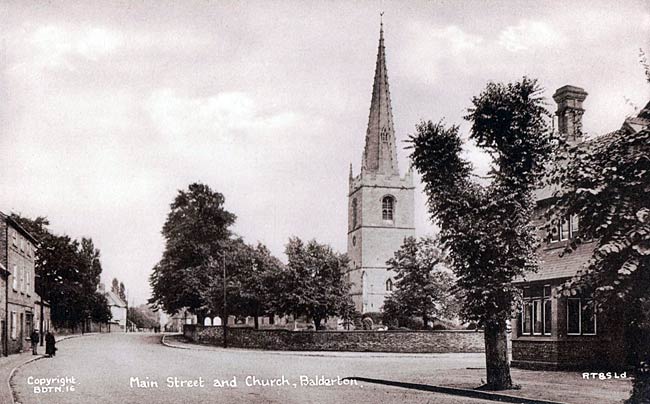
Main Street, Balderton, c.1920.
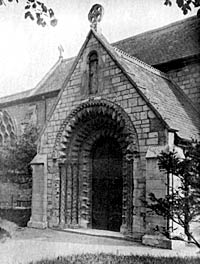
North porch of Balderton church, c.1911.
The church has fine work in wood and stone, one of its lovely things the 500-year-old spire crowning a 14th and 15th century tower. The oldest story is told by the Norman doorways in the 14th century south porch and the rebuilt north porch, whose handsome entrance arch is carved with zigzag and beak-heads. The lovely north door, adorned with tracery, is perhaps 600 years old.
Some of the capitals of the old nave arcades are enriched with foliage. There are many medieval windows, and in one of the lancets of the chancel is some old glass. There are two old piscinas, a priest's doorway, and a 14th century font with ballflowers. The panelled oak pulpit is old, and rare treasures of 15th century woodwork are the splendid chancel screen with the figure of a monk on one side and the Madonna on the other, and about 40 fine bench-ends with traceried panels, many of their poppyheads formed by pairs of rabbits.
By the Willows
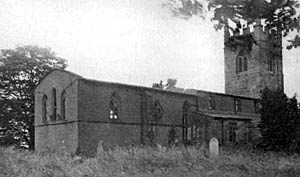
Barnby-in-the-Willows church, c.1911.
BARNBY-IN-THE-WILLOWS. A bright little village on the Witham, it is tucked away in a tranquil countryside, with a tower or spire adding to the friendliness of the scene on almost every hand. It has a fine old round dovecot with a red roof, a house with a quaint porch fashioned from a yew tree, a big house in a park a mile away, and a charming medieval church to which we come between deep yew hedges. Over the willow-lined stream bounding the churchyard we step into Lincolnshire.
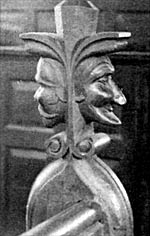
Bench-end, c.1911.
The two-storeyed tower is over 500 years old, the 14th century south porch is much restored, and the splendid 15th century north porch has a niche on each side of its wide entrance arch. A lovely 500-year-old door opens to the charming interior, which has many old benches with a few modern ones, looking like a garden of wooden flowers, their traceried ends crowned with poppyheads. Some of these are carved with faces and figures. One has a smiling face very like Mr Punch, the head of a grinning youth with his tongue out is between the heads of two women, an old man with staring eyes has a grotesque for a companion; one has two dogs and another two girls with curly locks.
The chancel of about 1300 is notable for the singular treatment of its window tracery. A stringcourse round the walls forms a transom across the side windows, and sometimes the tracery is below this as well as above. Between three lancets in the east wall are strange little openings. Both sides of the chancel are alike, and each has an unusual recessed window shaped like a diamond and filled with quatrefoil tracery.
The font and the nave arcades are 14th century, the altar table and the panelling in the sanctuary are 17th, and the parish chest is over 400 years old. An ancient coffin stone under the tower has a fine cross and the head and shoulders of someone now forgotten, the features worn away but the hands still at prayer.
The Doomed King Passes By
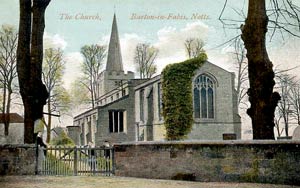
Barton-in-Fabis church, c.1905.
BARTON-IN-FABIS (or we may call it Barton in the Beans) nestles under hills by lovely Trent meadows, a quiet gathering of old houses, thatched cottages and farms, a fine old church surrounded by limes and chestnuts, and the old rectory close by.
More than once it has come into story. Brent's Hill was the site of extensive British and Roman fortifications. Many coins have been found there, and at Glebe Farm there could be seen until recent years the remains of a tessellated pavement of small coloured cubes which may have been part of a Roman villa. It was discovered last century, and after varying fortune came to the unseemly end of being a sackful of bits at the rectory.
For 200 years Barton was the home of the great Derbyshire family of Sacheverells. Their manor house is gone, but the wall that surrounded it and the old brick dovecot are still here, and their memorials are in the church. Henry of 1598 and Rafe of 1605 have inscriptions, and the name Sacheverell is on a marble tomb. William Sacheverell of 1616 and his wife lie side by side in alabaster, their hands and feet gone, both in ruffs, and Tabitha in a pretty headdress nnd a long gown with rucked sleeves.
Another William who knew the old house and died here sleeps in Morley church, Derbyshire. It was he, perhaps the greatest of the family, who resisted the attempt of James the Second to give Nottingham a new charter, and was fined heavily when Judge Jeffreys was sent to settle the trouble. He was an incorruptible politician, and is remembered as one of the first of our great orators.
Most of the church comes from the close of the 14th century, but the clerestory and the fine flat roof of the nave are of the time of Henry the Seventh. The tower has buttresses and a stair turret climbing to the top, and a fine spire with a tier of windows. Two of the bells are 1617, and four ring out in memory of the men who died for peace three centuries later.
Entered by a porch of 1693, the church is full of light, the stone walls attractive with the lines of their irregular coursing. The splendid nave arcade has four lofty bays; the chancel has three sedilia, a piscina niche with tiny recesses, a priest's doorway, and a canopied niche by the east window. The font is as old as the church. There is a Jacobean table, and the Jacobean pulpit has new panels. An old door in the nave has still its old bar fastening, and across the lofty narrow chancel arch is the fine old oak screen with gates.
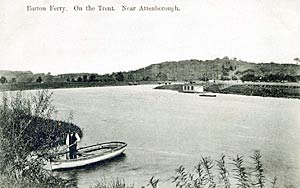
Barton Ferry, c.1910.
It may not be idle fancy to think that this little place has had a share in one of the great dramas of English history; that in the early hours of a May morning, nearly 300 years ago, the people may have been roused by the hard galloping of a small company of horsemen on their way to the river, little dreaming that a king was passing by on a fateful journey, his last ride as a free man. In 1646, when Charles Stuart had resolved to give himself up to the Scots, he set out for Southwell, reaching Stamford on the 3rd of May. It is believed he crossed the Trent near Gotham in his anxiety to miss Nottingham, and if this were so nothing is more likely than that he would cross by Barton Ferry and ride on past the very door of Henry Ireton's old home at Attenborough.
